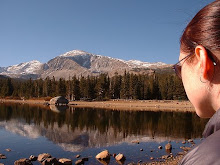Snapshots from the travel diary
Free time? What's that?In early August I spent a week travelling by train around the western U.S., and I thought I might share some of my journey. I had a notebook with me, so when something particularly struck me I scribbled it down.
Western Colorado: As the conductor tells us on the train, the section of the Colorado River between Granby and Glenwood Springs is known as "Moon River" because -- can you guess? -- rafters like to moon the passenger trains. Generally they're too far away to really get an eyeful, but you can see enough. If you can believe it, this has been only the second (and third, and fourth...) time I've been mooned. (The first was on a bus with my high school soccer team.)
Eastern Utah is rolling flatland between distant reddish-brown buttes, colors muted by distance like a watercolor painting. Short, dry grass with a rust-colored hue covers the ground, like an old carpet being taken over by radioactive mold, complete with worn bald spots where the dusty earth shows through.
The desert west of Winnemucca, Nevada, reminds me of a Pacific atoll: mounds of dry dirt, with clumps of scrubby green and brown plantlife clinging to the tops, rise in little groups out of the pervasive spread of gray-brown mud, baked to a hard, flat, cracked finish. Between the island groups lie wider expanses of flat gray mud, dried tight and crinkly under the glaring sun.
Roseville, California, is orchard country, dominated by neat rows of lush green trees on a gently-rolling landscape. Irrigation canals meander along from orchard to orchard, riding trussed aqueducts over sunken hollows and pastures. Oddball palm trees start to crop up here and there, their strangely tufted tops rising above the other native and imported greenery.
Descending from Oregon's Willamette Pass, the train winds down through evergreen-carpeted mountains, dwarfed by towering pines and firs on either side. The forest is dense, the spaces between the trees filled in by a thriving undergrowth that seems almost tropical in its lushness when compared to the dry, sparse pine forests of home.
Highway 26 west of Portland, Oregon, turns into a quiet 2-lane road once we leave suburbia for the dense evergreen forests of the rural foothills. Late in the day, the landscape of moss-covered tree trunks and rich undergrowth fade away into deepening shadow. It looks cool, shady, lush, and old, the kind of place you might find Bigfoot lurking off the beaten path. Early the next afternoon, under bright daylight, the deep green forests practically glow; what little sunlight filters down through the canopy makes the different shades of green all the more vibrant and rich.
We spent the night in Seaside, Oregon, and had free time this morning. We thought about the various sightseeing things we could do, and decided that all we really wanted to do was roam the beach, which is what we've spent the last 2 or 3 hours doing. We found a bunch of sand dollar shells and a few live ones (they were kind of furry, and came in various shades including dusky greens and purples), pieces and clumps of kelp and seaweed, crab shells and disembodied legs and claws, a few jellyfish, and patches of sand washed with glittering black minerals. The air is cool, only in the 50s or 60s, and the ocean water is cold, and it strikes us that the ocean air doesn't smell strongly of salt like we were accustomed to on the Atlantic seaboard. (My theory is that this is due to significantly lower humidity here.) My feet are slightly numb, having been in the water almost the whole time; earlier in the morning I was almost wading, wandering along the shore in water up to my knees, but later I stuck to shallower water so my pants could dry a bit. I rolled up my pant legs as far as they would go, and they still got soaked by the waves, and I can't bring myself to care all that much, because I am just so content. At home in Colorado, sometimes I miss the ocean like you wouldn't believe.
Entering the Rocky Mountains in western Montana, the train follows part of the Flathead River eastward for a while. I sit by a window, watching the clear, blue-green water winding through its channel below the railroad tracks; it is at times shallow and wide, rippling over a pebbled riverbed, and at other times it seethes as frothy white rapids, or flows clear and smooth through a deep, narrow channel. Glacier National Park is pretty but hazy, due to wildfires in the area, and we don't see anything worth special mention. I suppose we've been spoiled by the clear, grand vistas of the Colorado Rockies.
Between the Rockies and the Mississippi, the country seems to have been painted with broad strokes of homogenous landscape. North Dakota looks a lot like central and eastern Montana, which looks a lot like Nebraska and northeastern Colorado: semi-arid prairie farmland. Minnesota and Wisconsin look like Missouri and other areas thereabouts: wide, green farmland, lots of deciduous trees, thriving corn and wheat fields, tributary waterways here and there, and of course the wide, placid expanse of the Mississippi River.
--
Labels: imagine yourself here, travel


0 Comments:
Post a Comment
Subscribe to Post Comments [Atom]
<< Home